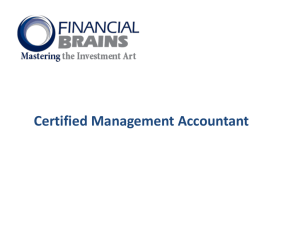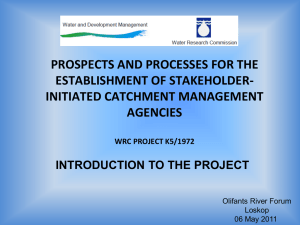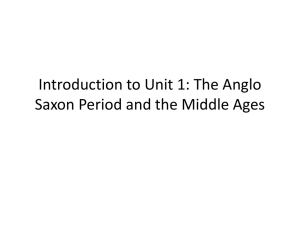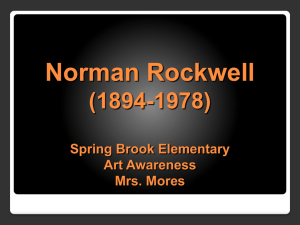JetFighterPresentation
advertisement
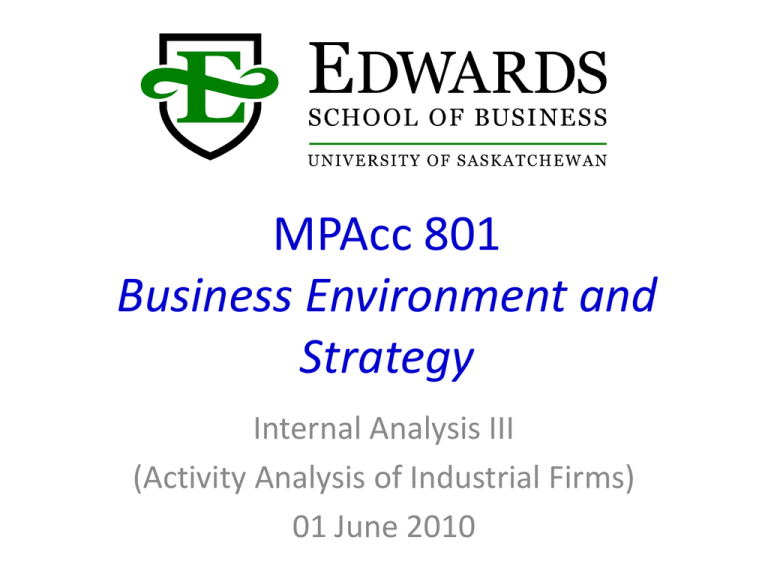
MPAcc 801 Business Environment and Strategy Internal Analysis III (Activity Analysis of Industrial Firms) 01 June 2010 Agenda 01.06.10 • Feedback on Part I Strategy Projects • Feedback on Half-way Survey • Internal Analysis III (Activity Analysis for Industrial firms) – Value Chain Analysis (read ‘Creating competitive advantage’ RP, review Chp 5 ‘Creating business strategies’ RP, plus review articles on BB) – JetFighter Competition • Please practice making planes prior to class to get full benefit! MPAcc 801 Spring 2010 Dr. Norman T. Sheehan, Ph.D, CGA, CMA Half-way Student Feedback • What do you like best about the course? – Interactivity, in-class exercises, hands-on nature, discussions – 33 – Group work and presentation practice – 7 – Strategy focus, strategic thinking – 6 • What would you change? – Feedback on first presentation before second – 10 – Less readings/content – 9 – All is good – 6 – Cheaper book – 4 MPAcc 801 Spring 2010 3 Dr. Norman T. Sheehan, Ph.D, CGA, CMA Half-way Student Feedback • I like it when the instructor: – Informs class of current events relating to strategy – 38 – Uses humor effectively – 9 – Facilitates discussions – 5 • I dislike it when the instructor: – Lectures – 2 – Is the board – 1 MPAcc 801 Spring 2010 4 Dr. Norman T. Sheehan, Ph.D, CGA, CMA Half-way Student Feedback • Most helpful assigned reading thus far: – Porter’s What is strategy? – 9 – Magretta’s What is Management? – 8 – Oil Patch Banker – 5 – Why companies fail – 3 – Are you sure you have a strategy? – 2 • Least helpful assigned reading thus far: – OSC Governance Principles – 8 MPAcc 801 Spring 2010 5 Dr. Norman T. Sheehan, Ph.D, CGA, CMA Half-way Student Feedback • Main concerns thus far – None – 9 – Applying knowledge to UFE – 8 – Too many assignments in next two weeks – 7 – Time pressure on presentations – 2 MPAcc 801 Spring 2010 6 Dr. Norman T. Sheehan, Ph.D, CGA, CMA Agenda 01.06.10 – Cont’d Next class Fri, 04 June • Blue Ocean Strategy and Innovation (read ‘Blue Ocean strategy’ BB, ‘The path to growth’ BB, ‘Using a value creation compass to find “blue oceans”’ BB, review Magretta Chp 7) • ‘Good Hands Healthcare’ case presentations, discussions, board Q&A – Groups 4,5,6 present the case (15 min), while groups 1,2,3 hand-in the case and act as the board/provide peer critique MPAcc 801 Spring 2010 7 Dr. Norman T. Sheehan, Ph.D, CGA, CMA Good Hands Healthcare Case Assignment (04 June) 1. 2. 3. Use concepts from the articles ‘Why do strategies fail?’ and ‘When growth stalls’ as well as any other relevant course readings to explain why Good Hands Healthcare is under-performing relative to its rivals. As part of this analysis, use Hambrick and Fredrikson’s (2005) strategy evaluation criteria (#1-5) from Table 1 (pg. 61) ‘Testing the Quality of Your Strategy’ to critique its current strategy. (50 points) Outline the key opportunities and risks for Good Hands Healthcare and then develop a new strategy for Good Hands that takes into account its strengths and weaknesses, changes in its environment, and its aspirations. (50 points) Critique Good Hands Healthcare’s current governance practices and propose changes to bring its governance up to 2010 NYSE governance standards. As part of your critique of and recommendations to improve Good Hands’ governance, propose what the Board should do with its current CEO, George Jackson, and discuss why. (50 points). You will be presenting to Good Hands Healthcare’s Board. MPAcc 801 Spring 2010 8 Dr. Norman T. Sheehan, Ph.D, CGA, CMA JetFighter Exercise • Your team is the senior mgmt group of the small and financially challenged JetFighter company. Your company has just won an important Government jet fighter contract that needs to be fulfilled immediately. In order to win the contract, your firm agreed to produce at least 5 planes each period. • The Gov’t inspector will buy all the jet fighters that exactly meet the Gov’t Purchasing Criteria laid out on last page of JetFighter Instructions • We will have three teams – two groups will build the Basic Training Plane, one group the Deluxe Combat Plane MPAcc 801 Spring 2010 Dr. Norman T. Sheehan, Ph.D, CGA, CMA JetFighter Exercise • Base Plane Price=$5M, Deluxe Plane Price=$10M • Raw materials cost varies by type of plane and amount purchased (see hand-out) • Your team goal is to earn most profit: Revenue – Cost (Planes Passed*Sales Price) – (Planes Bought*purchase cost) • Planes purchased but not completed or approved in Period 1, cannot be used in Period 2 as they become obsolete • There may be small problems with the raw materials, but there are no refunds (sorry) MPAcc 801 Spring 2010 Dr. Norman T. Sheehan, Ph.D, CGA, CMA Steps in JetFighter Part I 1. Organizing, Planning & Training – 15 min • Develop vision/mission, decide strategy, organize production, calculate break-even point and decide how many planes to produce, practice making planes… 2. Production Period 1 – 5 min 3. Instructor inspects/buys planes, calculates profit for each firm – 10 min 4. Review of Value Chain and Analysis and Discussion of how to improve your Period I results MPAcc 801 Spring 2010 Dr. Norman T. Sheehan, Ph.D, CGA, CMA Steps in Activity Analysis 1. Identify how the firm creates value – transformation, mediation, problem-solving 2. Use the correct template to break-down the firm and its competitors into its value creating activities 3. Analyze activities and look for ways to reduce cost • • Analyze activities Analyze critical drivers for each key activity 4. Analyze activities and look for ways to increase buyer willingness to pay • • Analyze activities Analyze critical drivers for each key activity 5. Goal is to drive the largest ‘wedge’ between the buyers’ willingness to pay and total cost to produce MPAcc 801 Spring 2010 Dr. Norman T. Sheehan, Ph.D, CGA, CMA Step 1 – Identify the Correct Value Configuration • Firms compete/create value differently: – Industrial firms (such a Ford) transform inputs into outputs – use value chain analysis (covered today) – Knowledge intensive firms (such as consulting firms) solve clients’ problems – use the value shop (covered 18 May) – Network firms (such as mobile phone companies) connect customers – use the value network (covered 18 May) MPAcc 801 Spring 2010 Dr. Norman T. Sheehan, Ph.D, CGA, CMA Step 2 – Break-Down Firm into Key Value Creating Activities • Support activities The value chain template has generic activity labels Infrastructure Human resource management Technology development Purchasing Primary In-going activities Logistics Production Out-going Sales& Service Logistics Marketing Need to allocate the firm’s actual activities to the correct categories MPAcc 801 Spring 2010 Dr. Norman T. Sheehan, Ph.D, CGA, CMA Activities of a PC Manufacturer Infrastructure – Planning, Organizing, Gov’t relations, Quality Human resource mgmt – Recruiting, Training, Compensation Technology development – Design of product or process Purchasing – Acquiring the raw materials In-going Logistics – Handling Raw Mats, Inspection, Inventory Production – Assembly, Operation of Plant, Testing, Maintenance MPAcc 801 Spring 2010 Out-going Logistics – Storing, Order Process, Shipping Sales & Marketing – Advt, Promotion, Mgmt of Salesmen Service – Technical Support, Repairs, Service Reps Dr. Norman T. Sheehan, Ph.D, CGA, CMA Step 3 – What are Drivers? • Drivers are those contextual factors (e.g., where the activity is performed, how many time the activity has been performed, how the activity is performed, etc.) which explain why the cost of an activity is higher/lower than competitors or the value generated by an activity generates is higher/lower than competitors MPAcc 801 Spring 2010 Dr. Norman T. Sheehan, Ph.D, CGA, CMA Step 3 – Identify Key Drivers (Porter, 1985) – – – – – – – – When was the activity started? (Drivers – Learning & Timing) How large are the activities compared to competitors (Driver – Scale) How large is the capacity of the activity relative to what is being used? (Driver – Capacity Utilization) How is the activity is related/coordinated with other activities in the firm or or activities in sister units or activities of suppliers/ buyers (Drivers Linkages and Interrelationships) Strategic choices regarding product features, variety, complexity of mfc processes, buyers served, etc (Driver – Policy Choices) Where is the activity performed relative to suppliers, customers, etc? (Driver – Location) Who performs the activity – is it done in-house or outsourced? (Driver – Integration) Gov’t regulations impacting an activity (Driver - Institutional Factors) MPAcc 801 Spring 2010 Dr. Norman T. Sheehan, Ph.D, CGA, CMA Key Cost Drivers in Value Chains Scale Driver Learning Driver Unit cost Unit cost Time Quantity Capacity Utilization Capacity Linkages Driver Supplier Producer Buyer Units Made Jan Apr MPAcc 801 Spring 2010 Jul Oct Dr. Norman T. Sheehan, Ph.D, CGA, CMA Step 4 – Compare to Competitors • Performance is relative! • Two Level of Comparison: – First Cut • Compare activity sets – Second Cut • Compare at level of drivers • If more than one driver use 80/20 rule to narrow it down – which driver causes 80% of the difference in the activity’s cost/value? MPAcc 801 Spring 2010 Dr. Norman T. Sheehan, Ph.D, CGA, CMA Step 5 – Improve Your Firm’s Position Generic Strategy Key Strategic Success Factors Low Cost Strategy •Economies of scale •Transfer of best practices to sister units •Economies of scope •Superior low cost production technologies Differentiation •Unique styling/superior product design Strategy •Customization •Speed •Convenient access •Unusually high quality •Premium brand image MPAcc 801 Spring 2010 Key Threats •Inferior product quality •Rivals adopt newer, lower cost production technologies •Social, economic and political risks of outsourcing production to low cost countries •Buyers do not perceive diff. or unwilling to pay higher prices •The cost of differentiation exceeds buyer willingness to pay •Over-fulfill buyer needs •Lower cost firms successfully imitate the diff. offering Dr. Norman T. Sheehan, Ph.D, CGA, CMA Step 5 – Improve Your Firm’s Position • Look for ways to lower the firms’ cost or increase the level of differentiation offered (i.e. try to drive a larger ‘wedge’ between the buyer’s willingness to pay and the total cost to produce the product/service) MPAcc 801 Spring 2010 Dr. Norman T. Sheehan, Ph.D, CGA, CMA Steps in Jet Fighter Part II 1. Planning for Period 2 – 20 min 2. Production Period 2 – 5 min 3. Instructor inspects/buys planes, calculates profit for each firm – 10 min 4. Declaration of a winning group – who earned the most profit? Winners of 2nd Round get a 10 for the day!! 5. Wrap-up discussion – see Discussion Questions MPAcc 801 Spring 2010 Dr. Norman T. Sheehan, Ph.D, CGA, CMA JetFighter Discussion Questions II • • • • Did you fulfill your mission/vision? Why or why not? Why did the winning firm win? What are the key success factors? Outline what you would do to improve your team’s performance in Round 3? What are the pros and cons of value chain activity analysis? MPAcc 801 Spring 2010 Dr. Norman T. Sheehan, Ph.D, CGA, CMA Issues with Value Chain Analysis • Value chain does not fit with every firm • Data intensive • Complicated and time-consuming analysis, especially at the level of drivers • Hard to get information MPAcc 801 Spring 2010 Dr. Norman T. Sheehan, Ph.D, CGA, CMA Key Questions in Activity Analysis • Which of the firm’s activities create value (i.e. what do the customers really pay for)? Can this be increased? • In which activities are the costs incurred? What affects costs? Can costs be reduced without impacting buyer value? • Which activities should the firm do itself? What can the firm outsource? • How are the activities organized? Can it be done more efficiently and/or effectively? MPAcc 801 Spring 2010 Dr. Norman T. Sheehan, Ph.D, CGA, CMA Link to Strategy Project II 1. Identify how the firm creates value – transformation, mediation, problem-solving – choose the correct value configuration 2. Use the suggested template to break-down the firm into its value creating activities 3. Analyze critical drivers for each key activity 4. Do steps 2&3 for each of firm’s competitors • • First Cut Analysis – compare at activity level Second Cut Analysis – compare at driver level 5. Revise Strategy to increase the ‘wedge’ MPAcc 801 Spring 2010 Dr. Norman T. Sheehan, Ph.D, CGA, CMA
